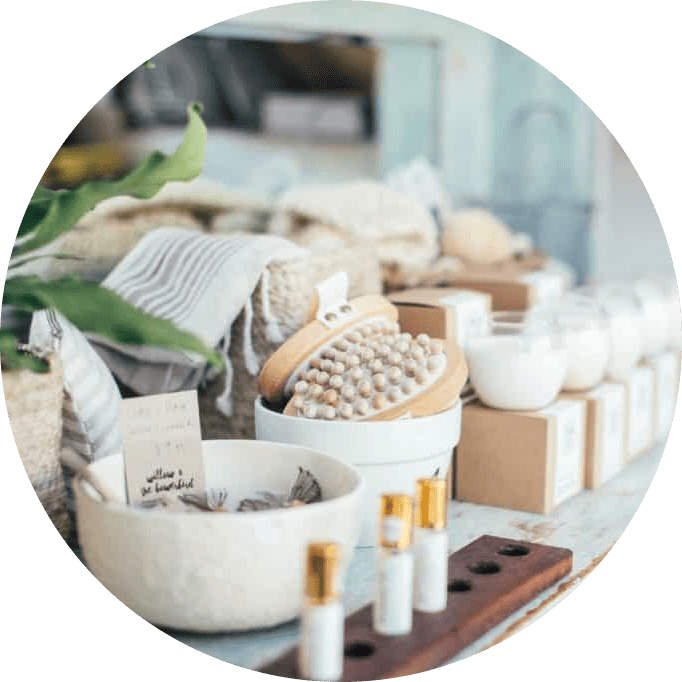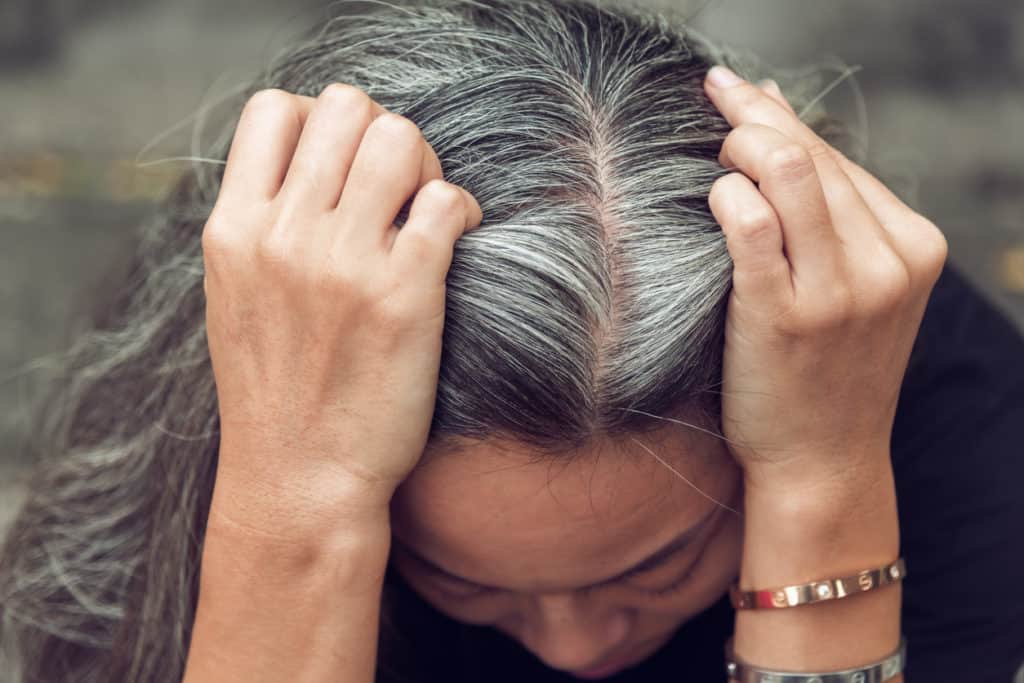Whether you have naturally oily hair or love to use oils in your haircare routine, you need to remove it without stripping the natural oils that keep your hair and scalp moisturized.
Rather than relying on harsh products, use natural ingredients to help remove oil naturally from the hair.
Managing excess oil in your hair is easier than you think, and many natural ingredients often have other beneficial properties to help improve the look and feel of your hair while they rid it of excess oil!
The Best Natural Way To Remove Oil From The Hair!
Try these natural methods for simple, effective, and affordable ways to get oil from your hair while leaving it clean and healthy!
- Cornstarch* or Arrowroot*.
- Baking Soda
- Cosmetic Clay
- Aloe Vera Gel*
- Apple Cider Vinegar
- Lemon Juice
- Tea Rinses
- Rosewater
All affiliate links are marked by an *. We may earn a small commission if you purchase through these links, but it will not affect your sales.
If you suffer from certain scalp conditions or have sensitive skin, you may want to consult with a dermatologist before using these ingredients.
Cornstarch or Arrowroot Powder.
Arrowroot powder and cornstarch are great for removing oils from the hair due to their natural absorption properties.
Arrowroot is derived from the roots of the arrowroot plant, while Cornstarch is made from the endosperm of corn kernels. Both are effective for soaking up excess oil from the scalp and hair.
- Sprinkle a small amount of cornstarch or arrowroot powder onto your roots.
- Comb through your hair to distribute the powder evenly.
It’s important to note that while arrowroot and cornstarch can be effective for absorbing oil, they may leave a white residue on darker hair, so brush thoroughly to distribute it and minimize this effect.
Both these ingredients are commonly used in natural DIY dry shampoos; get this recipe!
Baking Soda.
Baking soda, or sodium bicarbonate, is known for its ability to help remove excess oil and residue from the hair. Here’s why baking soda is effective at getting oil from the hair:
Baking soda is alkaline, which means it has a higher pH; this helps to break down and dissolve oils, dirt, and debris that have built up on the hair and scalp. It is also mildly abrasive and can be massaged in to remove oil, and it has absorbent properties.
Baking soda has many beauty uses, such as cleansing and clarifying.
Here’s a simple way to use baking soda for oil removal in the hair:
- Mix a small amount of baking soda with water to create a paste.
- Apply the paste to your wet hair, focusing on the roots and oily areas.
- Gently massage the scalp to distribute the mixture.
- Allow it to sit for a few minutes.
- Rinse thoroughly with water.
Use baking soda sparingly. Excessive or frequent use can strip the hair of its natural oils, disrupt the scalp’s pH balance, and lead to dryness or irritation. Moderate use, though, is very effective in removing an oily build-up!
Follow up with a mild, gentle conditioner.
Buy pure, premium-quality baking sodas*.
Clay Masks.
Cosmetic clay is a fantastic natural ingredient for hair and has many benefits. Making homemade clay hair masks will give you fuller, softer hair, as it detoxes the scalp and removes excess oil and build-up from the hair.
These are the best clays for the hair. Use them alone or in hair mask recipes!
- Natural clays like bentonite or kaolin should be mixed with water to create a thick paste.
- Apply the clay mask to your scalp and leave it on until it dries.
- Rinse out the clay, removing excess oil and impurities.
Buy clay* for the hair.

Aloe Vera Gel.
Aloe vera is a versatile plant known for its various health and skincare benefits, and it can also contribute to managing oil on the scalp. Here’s why aloe vera is considered beneficial for removing oil from the scalp:
Aloe vera has natural astringent properties, which can help constrict or tighten tissues. This can reduce excess oil on the scalp by tightening the pores and minimizing oil production.
It also contains enzymes that can help break down and remove dead skin cells, excess oil, and other impurities from the scalp.
Aloe vera can balance the skin’s pH levels. If the scalp is too oily, aloe vera can help regulate the oil production, making it an effective solution for both oily and combination scalps.
Aloe vera is hydrating without being greasy. It can moisturize the scalp and hair without adding excess oil, making it suitable for those with oily scalps who still need hydration.
Here’s a simple way to use aloe vera for managing oil on the scalp:
- Extract fresh aloe vera gel from a leaf or use a commercially available pure aloe vera gel*.
- Apply the gel directly to the scalp, focusing on the roots and areas with excess oil.
- Gently massage the scalp to ensure even distribution.
- Leave it on for about 15-20 minutes.
- Rinse thoroughly with water.
While most people tolerate aloe vera well, you should perform a patch test before using it extensively if you have allergies or sensitive skin. Look for pure, natural aloe vera that is filtered to get the best results.
Apple Cider Vinegar (ACV).
Knowing about the minimal cleansing routine of baking soda and apple cider vinegar, you will be familiar with apple cider vinegar as a clarifying hair growth ingredient.
Apple cider vinegar has many benefits for hair. This simple natural ingredient is a great way to remove oil, residue, and build-up from the hair.
- Mix one part apple cider vinegar with one part water.
- Apply the mixture to your scalp and hair.
- Allow it to sit for a few minutes before rinsing thoroughly.
You can also use apple cider vinegar as the liquid in homemade hair masks.
Buy Apple cider vinegar* with the mother for the purest form.
Lemon Juice.
Lemon juice is an incredible natural vitamin C ingredient with many hair and skin benefits. It is also well known as a natural lightening agent for the hair. Still, its astringent and clarifying properties make it a great natural ingredient to remove any excess oil from the hair.
- Mix half a lemon juice with one cup of water.
- Apply the mixture to your scalp and hair.
- Allow it to sit for a few minutes before rinsing.

Tea Rinse.
Tea rinses have fantastic benefits for the hair; they can enhance color or help prevent shedding. While Tea may not directly remove oil from the hair like a traditional shampoo, it can have some benefits for managing oiliness and promoting overall hair health.
Here’s how a tea rinse may help with oiliness in the hair:
- Cleansing Properties: Certain types of tea, such as black or green tea, contain antioxidants and astringent properties that can help remove excess oil from the scalp and hair. The tannins in tea have natural cleansing properties, which may help reduce the oil in your hair.
- Balancing the Scalp: Tea rinses may help balance the pH levels of the scalp. An imbalanced pH can contribute to excessive oil production. By restoring balance, the scalp is less likely to overproduce oil.
- Reducing Dandruff: Some teas have antifungal and antibacterial properties that help control dandruff. Tea rinses indirectly contribute to a healthier scalp and less oiliness by addressing dandruff.
Here’s a simple guide on how to use a tea rinse for your hair:
- Brewing the Tea: Brew a strong cup of tea using black, green, or herbal tea bags. Let it cool to room temperature.
- Application: After shampooing your hair, pour the cooled tea over your hair, making sure to saturate your scalp and hair strands. You can catch the excess tea in a bowl and reapply it several times.
- Massage and Rinse: Gently massage your scalp for a few minutes to ensure the tea reaches the roots. Leave it on briefly, then rinse it with cool water. You can follow up with your regular conditioner if needed.
Rosewater.
Rosewater is known for its mild astringent and balancing properties, making it potentially beneficial for oily hair. It can help soothe the scalp, control excess oil, and leave the hair with a pleasant fragrance.
Rosewater is a gorgeous floral hydrosol with centuries of beauty uses. If you suffer from oily hair, don’t just use this product as a face refresher and toner. Rosewater spritzed into the hair will help to;
- Balance the scalp: Rosewater has natural balancing properties, which can help regulate the production of sebum (natural oils) on the scalp, which can help with oily hair.
- Mild Astringent: Rosewater acts as a mild astringent, helping to tighten the pores on the scalp. This tightening effect can reduce excess oil and promote a healthier scalp environment.
- Refreshing and Fragrant: Rosewater will help refresh hair that needs washing and add a beautiful scent!
How to Use Rosewater for Oily Hair.
Buy organic pure Rosewater* without added preservatives or artificial fragrances for the best results!
If you have sensitive skin, you can dilute rosewater with water.
Application: Pour the rosewater (or diluted) into a spray bottle for easy application.
Spray onto Scalp and Hair: Part your hair and spray the rosewater directly onto your scalp and hair. Focus on the roots and areas where oil tends to accumulate.
Massage: Use your fingertips to massage the rosewater into your scalp using circular motions. This helps distribute the rosewater and stimulates the scalp.
Leave it on: Allow the rosewater to air dry. There’s no need to rinse it out.
You can use rosewater as often as needed to freshen up your hair!
Buy premium natural rosewater* for the best results, and discover other ways to use it!
Conclusion.
Remember to focus on your roots and scalp while applying these remedies, as that’s where the excess oil accumulates. Also, be cautious with the frequency of use, as some ingredients may be drying if overused.
Try not to wash oily hair too much, as that stimulates oil production, and you get caught in a cycle; these natural ingredients can be a great help to combat this issue!
Experiment with these natural methods to find the one that best suits your hair type and preferences.
This post contains affiliate links. If you purchase through these links, marked with a *, we may earn a small commission, which will not affect your sales.
Glowitgreen.com is a member of the Amazon affiliate link program.




